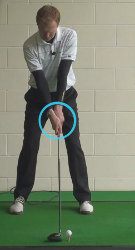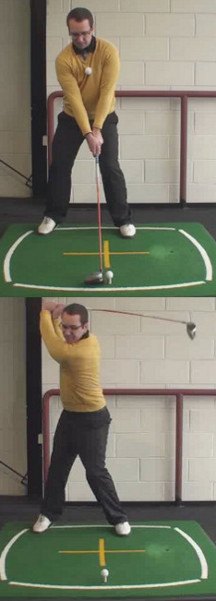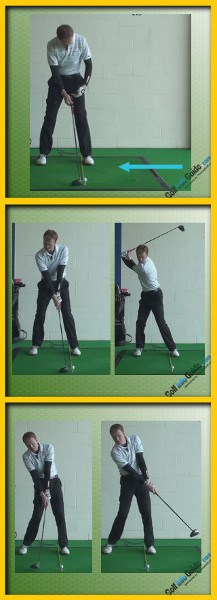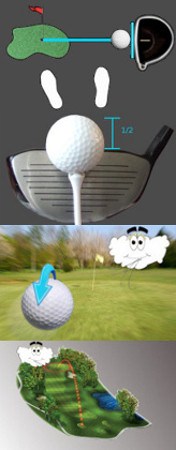
Looking for a quick and easy way to increase your driving distance? Work on hitting the ball higher.
A high-sailing drive naturally stays in the air longer and carries farther than one hit on a low trajectory. That's why professional clubfitters recommend using a driver with substantial loft – as much as 13 degrees for some golfers.
Without changing drivers, here are a few things you can do to hit higher, longer tee shots:
• Tee the ball with plenty of height: About half the ball should sit above the top line of the clubface. Modern drivers deliver maximum carry when the ball is struck just above the center.
• Play the ball off your left heel (right-handers): With your left toe flared slightly toward the target, the ball should be even with the left heel at address.
• Right shoulder slightly below the left at setup: This will put you in position to catch the ball on the upswing, utilizing all the club's loft.
To truly get the most from today's golf drivers, a fitting is recommended. Many pros and shops offer fitting services, or you can go the online route with retailers such as Thomas Golf (For more information on Thomas Golf drivers click here).

Best Tips for Hitting Longer Golf Drives
Golf should be about fun first and foremost. After all, this is a game, right? There is nothing wrong with working hard to shoot the lowest scores possible, but you should be having fun all along the way. If you aren't enjoying your time on the driving range and on the course, you might as well find something else to do with your free time. The golfer who isn't having fun will soon find something else to do.
Speaking of fun, there is one thing that nearly every golfer can agree ranks right at the top of the enjoyment scale on the golf course – blasting a long drive from the tee. There is something about seeing the ball disappear into the distance after making an aggressive driver swing that will keep your coming back for more time after time. In addition to the advantages that this ability provides you – shorter approach shots, clearing hazards in the fairway – it is just plain enjoyable to hit long drives. Of course, having bragging rights over your playing partners doesn't hurt either.
In this article, we are going to highlight some of the best available tips for hitting longer drives. Despite what you might think, you don't have to overhaul your entire swing in order to hit the ball farther. Nor do you need to spend hours in the gym each day to add a bit of swing speed. You don't even have to buy expensive drivers or upgraded shafts. As long as you are willing to pay attention to the small details within your technique, you can pick up yards without making any huge changes. Also, you can find yards through the strategy you use on the course, so we will explore that avenue as well. In the end, we hope this article leaves you with plenty of ideas for how you can tack yards onto your drives in your very next round.
As you are working on your driving distance, remember to avoid getting too caught up in the chase for additional yardage. Sure, it is great to hit the ball a long distance, but you need to be able to control those drives as well. If you throw out your technique in favor of swinging as hard as possible, you will soon grow frustrated with your inability to hit the fairway. Everything in golf is a balance – you want to add distance, but you need to make sure that distance comes along with the control necessary to keep your ball in play. If at any point you feel like you are losing control over the ball, slow things down and return to the basics. It is better to be a short, accurate hitter than it is to be a powerful player who is constantly searching for his or her golf ball in the woods.
All of the content below is based on a right-handed golfer. If you happen to play left-handed, please take a moment to reverse the directions as necessary.

Some Distance Basics
The points contained in this section should be considered the building blocks of long drives. They are points which are well-known by most golfers, but they should be reiterated here because of their importance. Make sure you are checking all of these boxes first before you move on to any other methods of adding yards to your drives.
- Use a full-size driver head. The largest club head allowed under the rules of golf is 460cc's – and you should be using a club which goes right up to that limit. By using a full-size head, you will maximize the forgiveness you experience at impact, meaning your average drive should travel further. Sure, you can hit long drives with smaller club heads, but you have to be more accurate in terms of hitting the sweet spot. Larger heads tend to be more forgiving, so you will get more yardage out of shots which miss the sweet spot slightly. Fortunately, most of the drivers on the market today come in at the 460cc limit, so it should be easy to find one that suits your needs. Remember, you don't necessarily have to buy the most expensive driver on the market in order to get a good club – there are plenty of options at lower price points which will work just fine for the average golfer.
- Tee the ball high. Many amateur golfers tee the ball too low to ever maximize their distance capability. Don't make that mistake. At address, the ball should be high enough to have the top line of the driver roughly equal to the equator of the ball. In other words, half of the ball should be above the top of the driver prior to starting your swing. This tee position will allow you to hit up through the shot, which is what you need to do if you are going to maximize distance. It might look a little strange to you at first to tee the ball so high, but you should get used to it quite quickly.
- Make a full shoulder turn. A great shoulder turn really is the basis of a powerful drive. Without plenty of rotation in your shoulders, you are never going to generate the speed necessary to launch the ball down the fairway. Take your time going back and make sure your left shoulder is behind the ball before your downswing starts. If you are having trouble making a full turn due to limited flexibility, try turning your right foot out slightly at address. An open right foot will make the backswing easier to complete, and you should have more speed at the bottom as a result.
- Take your time. This point goes right along with the previous tip. In order to make a full shoulder turn, you need to take your time going back. It is easy to get in a rush when swinging the driver, as you want to hit the ball as hard as you can each time. However, there is a difference between hitting the ball hard and making a quick swing. You can take your time during the swing, as the only point that matters is the moment of impact. As long as the club is moving quickly at the bottom, it doesn't matter if the rest of the swing was relatively slow. In fact, you will probably find it easier to generate power while staying in control if you take your time during the swing.
- Let it go. You aren't going to hit long drives if you are too worried about steering the ball into the fairway. Yes, you want to be in control of your drives, but that control should come from solid mechanics and good timing. Once the swing has begun, you shouldn't be worried about trying to guide the ball into the short grass – you should just turn the club loose and accelerate aggressively through impact. With this kind of aggressive attitude in the back of your mind, you may be able to squeeze a few extra yards out of your drives without any other adjustments.
The points listed above will provide you with a foundation on which you can create some powerful tee shots. In fact, these tips might give you more than enough to work on for the time being. However, when you are ready for other ideas to help you locate extra yards, feel free to move on to the rest of this article.

Optimize Your Ball Flight
Swing speed is only going to take you so far in the quest for maximum distance. Sure, it is helpful to swing the club at a high rate of speed, but even the fastest swing needs to have an optimized ball flight to go with it. After all, if your drives are ballooning up into the air rather than travelling down the fairway, you won't be happy with the results in the end.
So how do you go about the process of optimizing your ball flight? The best option is to work with a club fitting professional. When you trust a fitting pro to help you optimize your flight, you will be putting technology on your side – which is always a good decision. Most modern fitting pros have a launch monitor on hand that they can use to help you dial in your performance. Once your current swing and ball flight have been analyzed, the pro will recommend changes you can make to add yards to your drives. These changes might involve picking up new equipment, or they may simply be changes to your technique.
If you decide to go ahead with a fitting session in order to find more yards with your driver, the following tips will help you get the most benefit from that session.
- Trust the pro. You are turning to a professional in this field because they have greater knowledge than you in terms of club fitting. With that in mind, trust their advice and resist the temptation to second guess what they are telling you about your swing. It is okay to ask questions, of course, but there is no point in going through the fitting process if you are only going to argue with the pro the whole time. Trust his or her experience and training in this area, and be open-minded about the advice you receive.
- Don't let your ego get in the way. Many amateur golfers ruin their fitting session by swinging as hard as possible in order to 'impress' the launch monitor. This is a pointless exercise. The whole point of a fitting session is to improve your performance on the course, so you need to stick with the swing you will actually use on the course when playing a round of golf. Don't swing 'out of your shoes' to maximize your readings – make normal swings and go from there.
- Tailor the fitting to your local course conditions. Maximizing your distance from the tee actually has a lot to do with thinking about where you usually play your golf. Do you tend to play a lot of golf on courses which are soft and soggy, or are conditions usually dry and fast in your area? Those playing on soft conditions are going to want to maximize carry distance, while those on dry courses can afford to find much of their distance along the ground. When optimizing your ball flight with the help of a club fitting pro, make sure you keep your local course conditions in mind.
Seeing the ball leave on a good trajectory is a great feeling, as you will know that you are going to get maximum distance from that particular swing. However, it is not always easy to find the right trajectory, which is why the help of a professional can be so beneficial. Club fitting sessions are relatively inexpensive, they usually only take around 30 minutes or so, and most facilities offer this service. Ask at your local course about club fitting services and schedule your appointment in the near future to tap into distance you may not have known you had in your bag.

It's All About Rotation
There are a few ways you can attempt to build speed in your golf swing. You can slide from side to side, dragging the club along with you as you go. Or, you can keep your body relatively still while using only your hands and arms to move the club. As you might have guessed, neither of these options are particularly effective. Without question, the best way to develop speed in the golf swing is to focus on rotation.
In the amateur game, it is easy to find golfers who sway from side to side as they try to pick up speed through the ball. Sadly, these efforts always fail, and most of them result in a slice. Rather than trying to slide to the left in the downswing, you should always be thinking about rotation. If you can make a great turn – both back and through – you will have plenty of power available to work with. There is going to be some lateral motion involved in the swing inevitably, but that motion should be as a result of the turn – not the other way around. Think only about rotating your body in place and you should be in great shape.
To make a powerful rotation, you have to be sure to start off in a balanced position. Take time to work on your address position during your next visit to the range, as having a solid stance is one of the best things you can do for your ability to hit long drives. Make sure your weight is balanced perfectly between your two feet as you stand over the ball, and keep your center of gravity mostly in place as the swing develops. Only in the follow through should your weight really move to the left, and that will only be the result of the momentum of your rotation carrying on through to the finish.
If you want to make sure that you are rotating rather than sliding, check on the position of your right knee during the backswing. It is common for amateur golfers to allow the right knee to drift away from the target early in the swing. In fact, this mistake is often the first sign of a slice. Make a few practice backswings and make sure your right knee is not going anywhere as the club moves away from the ball. There should be almost no movement at all in your lower body early in the backswing, and that certainly applies to your right knee. Hold steady in this key part of the body and you can expect to make a better rotation throughout the swing.

Finding Distance in Good Strategy
There is a lot of strategy in golf. Whether you notice it or not, you are making strategic decisions throughout the day on the golf course. From the time you step on the first tee, your entire round of golf is nothing but a string of strategy decisions. What club will you hit? What will you use as your target? What kind of ball flight will you use? The list of choices goes on and on. To play good golf, you not only have to make quality swings, you have to make quality choices as well.
As it pertains to adding distance to your driver, there are a few ways you can use strategy to send the ball farther down the fairway on a regular basis. Consider the following strategic tips as you work on an overall plan to increase driving distance. Of course, these tips will not apply to every hole you play, so pick and choose your spots wisely.
- Turn the ball over. All other things being equal, a draw is usually going to travel further than a fade. With that in mind, you should always be looking for opportunities to turn the ball over from right to left. If you can hit a draw, you want to do so as often as possible, because playing this shot shape is going to improve your average driving distance. Start the ball down the right side of the fairway, let it turn back toward the middle, and look forward to added yardage. You might be able to find a way to use your draw on holes that dogleg to the right, but don't force the issue too far. If a particular fairway is far better suited to receive a fade, you should do your best to hit a left to right shot – even if that means sacrificing a few yards in the process.
- Utilize the wind. This is an important point, as you can put the wind to your advantage far more often than you may realize. When the wind is behind you, the choice is easy – send the ball high up into the air and let it ride the breeze as far down the fairway as possible. You probably already understood that point, but you can actually use the wind to your advantage when it is coming from the side as well. If the wind is coming out of the right, play a draw and ride that breeze by moving your ball across the fairway. This type of shot is going to have plenty of sideways movement, but it will also have solid distance. The same can be done by hitting a fade with a breeze coming out of the left. The only problem with this strategy is having enough room to work – a narrow hole lined with trees isn't going to let you play tee shots in this manner. Also, should the breeze happen to be into your face, keep the ball down and limit spin to get as much distance from the shot as possible.
- Find the slopes. You want to use any slopes which may be available in the fairway to your advantage. For instance, if the left side of the fairway is flat, but the right side slopes down toward the green, you will likely want to use the right for the extra distance it offers. Take a moment while standing on the tee to analyze the design of the hole and plan your shot accordingly.
Hitting longer drives is both fun and beneficial for your game. By setting up shorter approach shots, you will likely have more birdie opportunities throughout the course of the day. You will also outdrive your playing partners more frequently – and that never gets old. By using the simple advice provided throughout this article, you should be able to tap into newfound power which will propel your ball farther down the fairway than ever before. As long as the rest of your game is holding up its end of the bargain, these long drives could help you record lower scores in the near future. Good luck!





